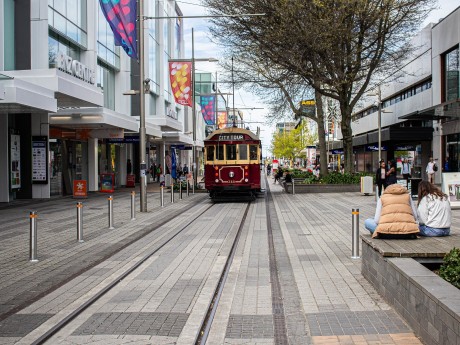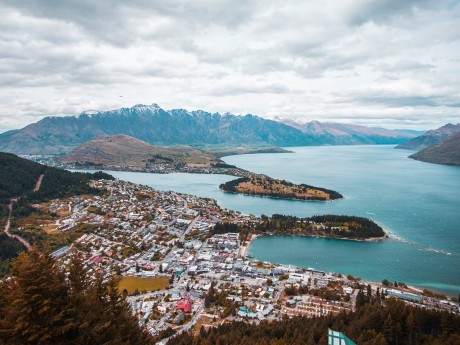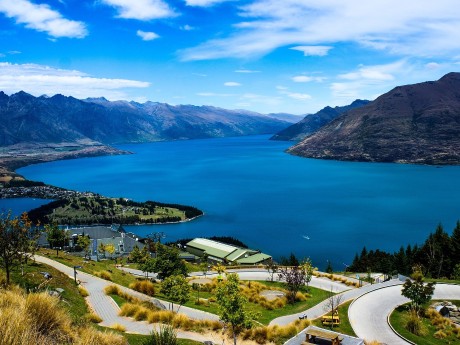Southern New Zealand: Christchurch & Queenstown
Get ready to explore New Zealand’s blend of culture, history and breathtaking scenery on your trip to Christchurch and Queenstown. Known as the “Garden City”, Christchurch is laden with beautiful gardens, parks and green spaces. Visit the Botanic Garden and walk along the river trail for serenity and mesmerizing beauty. Dive into the history of this resilient city by going to Quake City where you can experience the real life effects of the 2011 earthquake.
Read more
Get ready to explore New Zealand’s blend of culture, history and breathtaking scenery on your trip to Christchurch and Queenstown. Known as the “Garden City”, Christchurch is laden with beautiful gardens, parks and green spaces. Visit the Botanic Garden and walk along the river trail for serenity and mesmerizing beauty. Dive into the history of this resilient city by going to Quake City where you can experience the real life effects of the 2011 earthquake. After taking in the natural beauty and enriching yourself in the culture of Christchurch, a short flight will take you to Queenstown, “The Adventure Capital of the World”. With an extensive list of outdoor activities such as white water rafting, wine tours and jet boat rides, there is something for everyone here! Hikers will find paradise on the breathtaking trails that Queenstown has to offer. This trip captures the charm of Southern New Zealand, filled with natural beauty and rich history. Waterviews strives to offer accommodation options within walking distance of water and/or in an area of touristic interest. Our prices include taxes (but excludes local tourist taxes). Customize your trip to your personal preferences with optional activities (hit the “Add Activities’’) or change hotels, etc. Contact us for customization at no extra cost at: Service@waterviewstravel.com
Destinations
- Christchurch
- Queenstown (New Zealand)
Itinerary
Christchurch

Christchurch is a unique city that blends its rapid redevelopment and innovation with a vibrant culture and rich heritage. The largest city on New Zealand’s South Island, Christchurch’s flourishing and pedestrianised city centre is filled with lush botanic gardens and trees, and is a gateway to explore the nearby epic nature. Just a short drive away are the hidden bays and beaches of the Banks Peninsula, as well as Arthur’s Pass and Lake Tekapo.
Read more
Christchurch is a unique city that blends its rapid redevelopment and innovation with a vibrant culture and rich heritage. The largest city on New Zealand’s South Island, Christchurch’s flourishing and pedestrianised city centre is filled with lush botanic gardens and trees, and is a gateway to explore the nearby epic nature. Just a short drive away are the hidden bays and beaches of the Banks Peninsula, as well as Arthur’s Pass and Lake Tekapo.
Additional Information
Christchurch has a rich English heritage. This especially shows in the older buildings, especially in the cultural precinct along Worcester Boulevard (which is open from the Avon River towards the west), where most heritage buildings remain. The Avon River flows through the central city and disrupts the regular rectangular layout of the city streets.
Christchurch is known as the Garden City, a well-deserved name. Looking from a few floors up, one is struck by the number of trees that grow like a forest throughout the suburbs.
History
The Canterbury Association was established in London in 1848, with the intent of settling English emigrants in what was to become Christchurch and the Canterbury region. The city's name was chosen on 27 March 1848, named after the Christ Church college at the University of Oxford. The first settlers arrived in the future Christchurch in December 1850. Christchurch was declared a city in 1856, New Zealand's first. Construction began on the landmark ChristChurch Cathedral in 1864; the cathedral was completed and consecrated in 1881.
At 04:35 on Saturday, 4 September 2010, the city and region was hit by a magnitude 7.1 earthquake, located 10 km deep and 40 km west of the city centre. Parts of the city were damaged, but there were no fatalities. However, 5½ months later, at 12:51 on Tuesday, 22 February 2011, a magnitude 6.3 aftershock struck 10 km south of the city centre at 5 km deep. Already damaged buildings collapsed, killing 185 people, 115 of which resulted from the six-storey Canterbury Television building collapsing and catching fire. Many other central city buildings, old and new, were damaged beyond repair and were subsequently demolished. The landmark ChristChurch Cathedral lost its spire tower and most of its western facade. Liquefaction severely affected the eastern suburbs, resulting in 10,000 homes having to be abandoned due to land damage (the "residential red zone"). Some residents moved out of the city after the quake – many moved out to the Waimakariri and Selwyn Districts north and south of the city respectively, and some moved to other areas in Canterbury and further afield.
A very hip scene has developed in some of the suburbs close to the centre, and many 'gapfiller' projects (as part of the earthquake recovery) are stunning. In 2013, Lonely Planet declared post-earthquake Christchurch as one of the top 10 travel destinations in the world.
In March 2019, a white nationalist carried out consecutive terrorist attacks on two mosques in the city, killing 51 people in the deadliest mass shooting in modern New Zealand history. The suspect was arrested and is expected to go to trial in June 2020. The attacks resulted in a significant tightening of gun laws in New Zealand.
Climate
Like the rest of New Zealand, Christchurch has a temperate climate with four distinct seasons, mild to warm summers, cool winters, and rainfall evenly distributed throughout the year. The city is the driest of New Zealand's major cities with only 630 mm of rain per year, half of what Auckland and Wellington receive. This is due to the city being in the lee of the Southern Alps, which blocks the moist westerly winds off the Tasman Sea and causes the moisture to fall back as rain on the West Coast. The Southern Alps also causes a hot and strong foehn wind, locally known as the "Nor'wester", to blow across Christchurch and the Canterbury plains. The Nor'wester is most pronounced in summer and can cause temperatures in Christchurch to soar over . Christchurch occasionally receives snow during winter; on average one significant snowfall occurs in the city every 1 to 3 years.
© Sourced from Wikivoyage
Queenstown (New Zealand)

Widely known as the ‘adventure capital of the world’ and for good reason, Queenstown is a haven for adrenaline junkies. The birthplace of the bungee-jump, the city draws in visitors year-round to experience its exciting attractions. In spite of this, Queenstown offers something for everyone, boasting spectacular views from its harbour or from the top of Bob’s Peak which can be reached with the Skyline Gondola. By night, the compact centre offers excellent dining options as well as lively nightlife.
Read more
Widely known as the ‘adventure capital of the world’ and for good reason, Queenstown is a haven for adrenaline junkies. The birthplace of the bungee-jump, the city draws in visitors year-round to experience its exciting attractions. In spite of this, Queenstown offers something for everyone, boasting spectacular views from its harbour or from the top of Bob’s Peak which can be reached with the Skyline Gondola. By night, the compact centre offers excellent dining options as well as lively nightlife.
Additional Information
What was once a small, remote, South Island town has transitioned since the 1980s, first to a busy ski destination, and now to a year-round tourist mecca and centre for adventure tourism. It is a world-famous destination attracting around 1.9 million visitors every year, undoubtedly the tourism capital of the South Island if not New Zealand, and a must-see stop for most visitors to New Zealand.
Situated on the shores of Lake Wakatipu, New Zealand's third-largest lake (291 km2 or 112 sq mi) and one of Otago and New Zealand's most scenic lakes, surrounded by mountains, it's not hard to see why its stunning scenery draws people here year round. Queenstown happily caters for all visitors with a full range of attractions, activities, accommodation and eating options for any budget, from backpackers to five-star luxury. This popularity is not without its problems though - in many respects, Queenstown can be a tourist trap. However, reasonable prices and a few bargains can be found for those prepared to look for them.
Queenstown is a bustling town throughout the year, peaking over summer and during the ski season. There is a vibrant nightlife with the town's small central area packed with bars and restaurants. If you plan on getting a good nights sleep, then you might consider staying slightly out of town. It's common to see people on the streets up to 5AM returning from disco or pub. If you're looking for a relaxing scenic holiday, Wanaka (just over an hours' drive away) is smaller and more tranquil with less of a manic teenage party atmosphere.
Climate
Queenstown has a temperate climate with four distinct seasons, mild summers, cool winters, and rainfall evenly distributed throughout the year.
Local newspapers
The Mirror. The first of two free community newspapers to hit the streets (on Wednesday morning), The Mirror is a great source for catching up on all things that are happening in the entire Queenstown-Lakes area. In addition to the news articles, there is a weekly restaurant review and profile of a band or DJ that will be headlining at one of Queenstown's many nightspots that week.
Lakes Weekly Bulletin is an additional source of second-hand items for sale, community noticeboard, employment vacancies, film/gig guide, flatmates and rentals.
Visitor information
© Sourced from Wikivoyage





